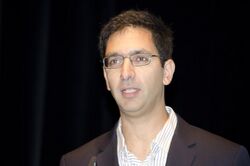Biography:Lior Pachter
Lior Pachter | |
|---|---|
 Lior Pachter in 2013 | |
| Born | Lior Samuel Pachter May 3, 1973 Ramat Gan, Israel |
| Alma mater | California Institute of Technology (BS) Massachusetts Institute of Technology (PhD) |
| Spouse(s) | Ingileif Bryndís Hallgrímsdóttir[citation needed] |
| Children | Three daughters[citation needed] |
| Awards | ISCB Fellow (2017) |
| Scientific career | |
| Fields | Computational biology Bioinformatics Genomics Computer science Mathematics[1] |
| Institutions | University of California, Berkeley |
| Thesis | Domino Tiling, Gene Recognition and Mice (1999) |
| Doctoral advisor | Bonnie Berger[2] |
| Doctoral students | Cole Trapnell[2][3] |
| Website | liorpachter |
Lior Samuel Pachter is a computational biologist. He works at the California Institute of Technology, where he is the Bren Professor of Computational Biology. He has widely varied research interests including genomics, combinatorics, computational geometry, machine learning, scientific computing, and statistics.[1][4][5]
Early life and education
Pachter was born in Israel and grew up in South Africa .[6] He earned a bachelor's degree in mathematics from the California Institute of Technology in 1994.[4] He completed his doctorate in mathematics from the Massachusetts Institute of Technology in 1999, supervised by Bonnie Berger,[2] with Eric Lander and Daniel Kleitman as co-advisors.[4]
Career and research
Pachter was with the University of California, Berkeley faculty from 1999 to 2018[7] and was given the Sackler Chair in 2012.[4]
As well as for his technical contributions, Pachter is known for using new media to promote open science[8] and for a thought experiment he posted on his blog according to which 'the nearest neighbor to the "perfect human"' is from Puerto Rico.[9] This received considerable media attention,[10] and a response was published in Scientific American.[11]
Awards and honors
In 2017, Pachter was elected a Fellow of the International Society for Computational Biology (ISCB).[12]
References
- ↑ 1.0 1.1 {{Google Scholar id}} template missing ID and not present in Wikidata.
- ↑ 2.0 2.1 2.2 Lior Pachter at the Mathematics Genealogy Project
- ↑ Trapnell, Cole; Pachter, Lior; Salzberg, Steven L. (2009). "TopHat: discovering splice junctions with RNA-Seq". Bioinformatics 25 (9): 1105–1111. doi:10.1093/bioinformatics/btp120. ISSN 1460-2059. PMID 19289445.
- ↑ 4.0 4.1 4.2 4.3 Curriculum vitae: Lior Pachter, 2017, https://pachterlab.github.io/Lior_Pachter_CV.pdf, retrieved 2017-05-16.
- ↑ Trapnell, Cole; Williams, Brian A; Pertea, Geo; Mortazavi, Ali; Kwan, Gordon; van Baren, Marijke J; Salzberg, Steven L; Wold, Barbara J et al. (2010). "Transcript assembly and quantification by RNA-Seq reveals unannotated transcripts and isoform switching during cell differentiation". Nature Biotechnology 28 (5): 511–515. doi:10.1038/nbt.1621. ISSN 1087-0156. PMID 20436464.
- ↑ Eskenazi, Joe (June 14, 2002), "U.C. divestment petition troubles pro-Israel activists", Jweekly, http://www.jweekly.com/article/full/17974/u-c-divestment-petition-troubles-pro-israel-activists/.
- ↑ "UC Berkeley, Mathematics Department Faculty, Lior Pachter". https://math.berkeley.edu/people/faculty/lior-pachter. Retrieved 8 June 2019.
- ↑ Lesen, Amy E. (2015), "A new paradigm for science communication? Social media, twitter, science, and public engagement: a literature review", in Lesen, Amy E., Scientists, Experts, and Civic Engagement: Walking a Fine Line, Ashgate Studies in Environmental Policy and Practice, Ashgate Publishing, Ltd., pp. 111–136, ISBN 9781472415240. See in particular pp. 119–120.
- ↑ Pachter, Lior (December 2, 2014). "The perfect human is Puerto Rican". https://liorpachter.wordpress.com/2014/12/02/the-perfect-human-is-puerto-rican/. Retrieved December 11, 2016.
- ↑ Valdez, Maria G. (December 4, 2014), "New Study Reveals The Perfect Human Genetically Speaking Is From This Caribbean Island!", Latin Times, http://www.latintimes.com/new-study-reveals-perfect-human-genetically-speaking-caribbean-island-280363
- ↑ Oleksyk, Taras K.; Martinez-Cruzado, Juan Carlos (February 5, 2015). "Why There Is No Perfect Human In Puerto Rico or Anywhere Else". Scientific American. http://blogs.scientificamerican.com/voices/there-is-no-perfect-human-in-puerto-rico-or-anywhere-else/..
- ↑ "February 13, 2017: The International Society for Computational Biology Names Seven Members as the ISCB Fellows Class of 2017". https://www.iscb.org/iscb-news-items/3067-2017-feb13-iscb-fellows-class-2017. Retrieved 13 February 2017.
External links

